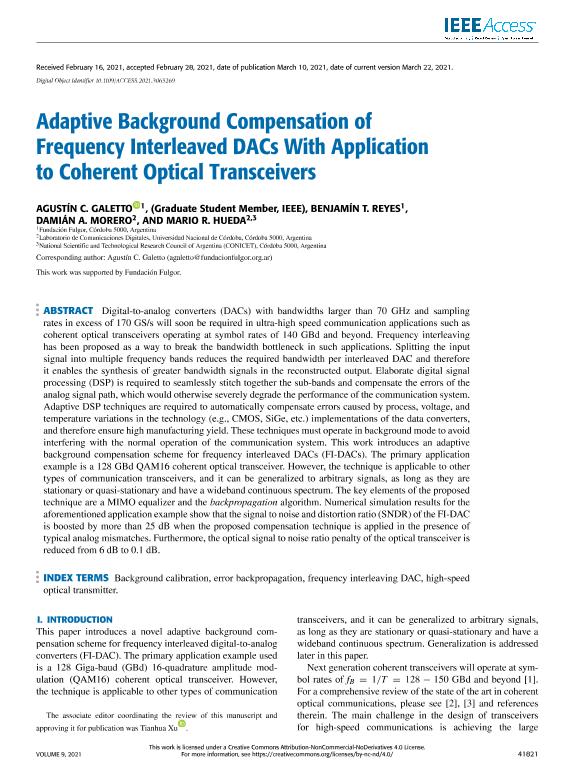Mostrar el registro sencillo del ítem
dc.contributor.author
Galetto, Agustín C.
dc.contributor.author
Reyes, Benjamín Tomás

dc.contributor.author
Morero, Damián Alfonso

dc.contributor.author
Hueda, Mario Rafael

dc.date.available
2022-01-21T12:48:22Z
dc.date.issued
2021-03
dc.identifier.citation
Galetto, Agustín C.; Reyes, Benjamín Tomás; Morero, Damián Alfonso; Hueda, Mario Rafael; Adaptive Background Compensation of Frequency Interleaved DACs with Application to Coherent Optical Transceivers; Institute of Electrical and Electronics Engineers; IEEE Access; 9; 3-2021; 41821-41832
dc.identifier.issn
2169-3536
dc.identifier.uri
http://hdl.handle.net/11336/150463
dc.description.abstract
Digital-to-analog converters (DACs) with bandwidths larger than 70 GHz and sampling rates in excess of 170 GS/s will soon be required in ultra-high speed communication applications such as coherent optical transceivers operating at symbol rates of 140 GBd and beyond. Frequency interleaving has been proposed as a way to break the bandwidth bottleneck in such applications. Splitting the input signal into multiple frequency bands reduces the required bandwidth per interleaved DAC and therefore it enables the synthesis of greater bandwidth signals in the reconstructed output. Elaborate digital signal processing (DSP) is required to seamlessly stitch together the sub-bands and compensate the errors of the analog signal path, which would otherwise severely degrade the performance of the communication system. Adaptive DSP techniques are required to automatically compensate errors caused by process, voltage, and temperature variations in the technology (e.g., CMOS, SiGe, etc.) implementations of the data converters, and therefore ensure high manufacturing yield. These techniques must operate in background mode to avoid interfering with the normal operation of the communication system. This work introduces an adaptive background compensation scheme for frequency interleaved DACs (FI-DACs). The primary application example is a 128 GBd QAM16 coherent optical transceiver. However, the technique is applicable to other types of communication transceivers, and it can be generalized to arbitrary signals, as long as they are stationary or quasi-stationary and have a wideband continuous spectrum. The key elements of the proposed technique are a MIMO equalizer and the backpropagation algorithm. Numerical simulation results for the aforementioned application example show that the signal to noise and distortion ratio (SNDR) of the FI-DAC is boosted by more than 25 dB when the proposed compensation technique is applied in the presence of typical analog mismatches. Furthermore, the optical signal to noise ratio penalty of the optical transceiver is reduced from 6 dB to 0.1 dB.
dc.format
application/pdf
dc.language.iso
eng
dc.publisher
Institute of Electrical and Electronics Engineers

dc.rights
info:eu-repo/semantics/openAccess
dc.rights.uri
https://creativecommons.org/licenses/by-nc-sa/2.5/ar/
dc.subject
BACKGROUND CALIBRATION
dc.subject
ERROR BACKPROPAGATION
dc.subject
FREQUENCY INTERLEAVING DAC
dc.subject
HIGH-SPEED OPTICAL TRANSMITTER
dc.subject.classification
Telecomunicaciones

dc.subject.classification
Ingeniería Eléctrica, Ingeniería Electrónica e Ingeniería de la Información

dc.subject.classification
INGENIERÍAS Y TECNOLOGÍAS

dc.title
Adaptive Background Compensation of Frequency Interleaved DACs with Application to Coherent Optical Transceivers
dc.type
info:eu-repo/semantics/article
dc.type
info:ar-repo/semantics/artículo
dc.type
info:eu-repo/semantics/publishedVersion
dc.date.updated
2021-11-12T14:25:23Z
dc.journal.volume
9
dc.journal.pagination
41821-41832
dc.journal.pais
Estados Unidos

dc.description.fil
Fil: Galetto, Agustín C.. Fundación Fulgor; Argentina
dc.description.fil
Fil: Reyes, Benjamín Tomás. Fundación Fulgor; Argentina. Consejo Nacional de Investigaciones Científicas y Técnicas; Argentina
dc.description.fil
Fil: Morero, Damián Alfonso. Universidad Nacional de Córdoba; Argentina
dc.description.fil
Fil: Hueda, Mario Rafael. Consejo Nacional de Investigaciones Científicas y Técnicas. Centro Científico Tecnológico Conicet - Córdoba. Instituto de Estudios Avanzados en Ingeniería y Tecnología. Universidad Nacional de Córdoba. Facultad de Ciencias Exactas Físicas y Naturales. Instituto de Estudios Avanzados en Ingeniería y Tecnología; Argentina
dc.journal.title
IEEE Access
dc.relation.alternativeid
info:eu-repo/semantics/altIdentifier/url/https://ieeexplore.ieee.org/document/9374421
dc.relation.alternativeid
info:eu-repo/semantics/altIdentifier/doi/http://dx.doi.org/10.1109/ACCESS.2021.3065269
Archivos asociados
